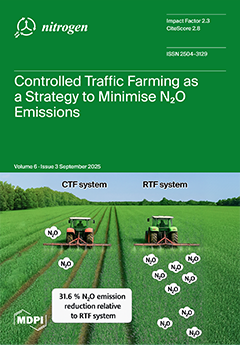Soil water availability can become one of the decisive factors for crop production. The technology of coinoculation with plant growth-promoting bacteria capable of performing biological nitrogen fixation and producing plant hormones may be an alternative that minimizes the effects of variations in soil water availability. In this context, the objective was to evaluate the phytometric and productive characteristics of cowpea coinoculated with
Azospirillum brasilense and
Bradyrhizobium japonicum subjected to soil water availability stress. The experiment was carried out in a greenhouse in a completely randomized block design with four replications in a 4 × 4 factorial arrangement: not inoculated; inoculated with
B. japonicum; and coinoculated with
B. japonicum +
A. brasilense and N fertilizer, associated with soil water tensions of 15, 30, 45, and 60 kPa. Statistically, the lowest soil water tension, 15 kPa, and the coinoculated and nitrogen fertilizer treatments resulted in greater development of plant height, stem diameter, and number of leaflets. The shoot dry mass was significantly different for only the soil water stress treatments, which showed a decrease in mass accumulation from 15 kPa to 50.22 kPa. Regarding the SPAD index, soil water tension showed a decreasing linear adjustment 24 days after plant emergence (DAEs), with the lowest value of 51.38 at a tension of 60 kPa. At 39 DAEs, the adjustment was polynomial, with the lowest tension index of 59.62 kPa, corresponding to 44.14. The treatments with the use of inoculants had a significant effect on the SPAD index, in which coinoculation with
Bradyrhizobium and
Azospirillum brasilense resulted in values equal to those of nitrogen fertilizer and greater than those of uninoculated treatments or those inoculated with
Bradyrhizobium. Water tension influenced the total water consumption, and at a tension of 18.13 kPa, the lowest accumulation occurred, equivalent to 2.20 g of dry matter for each liter of irrigated water. Statistically, the lowest soil water tension, 15 kPa, resulted in higher numbers, lengths, and widths of pods. In relation to the length of pods, the uninoculated, inoculated with
Bradyrhizobium, and coinoculated with
Bradyrhizobium and
A. brasilense treatments were superior to nitrogen fertilization. Coinoculation and nitrogen fertilization influenced phytometric characteristics. The productive characteristics of cowpea decreased as the soil water tension increased. These results highlight the importance of leveraging biological solutions, such as coinoculation, to mitigate the adverse effects of water stress on crop yields. In addition, by optimizing these practices, farmers ensure greater resilience in bean production, thereby guaranteeing food security in the face of changing environmental conditions.
Full article





